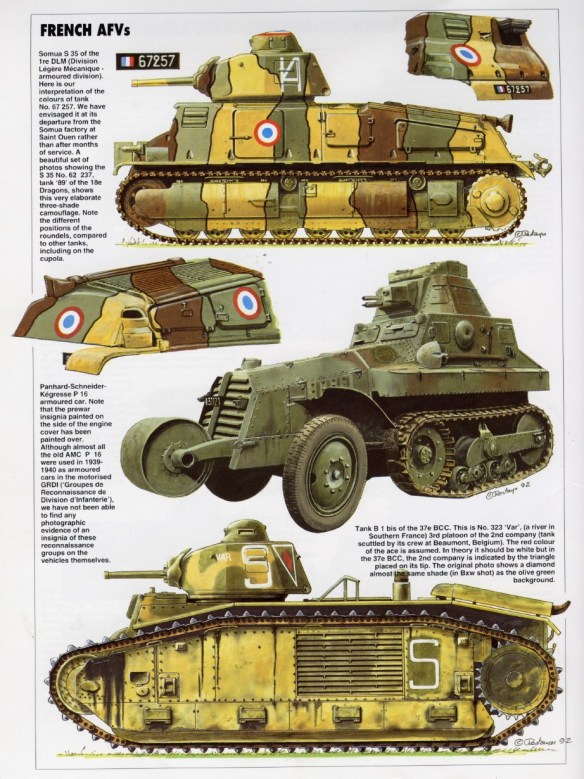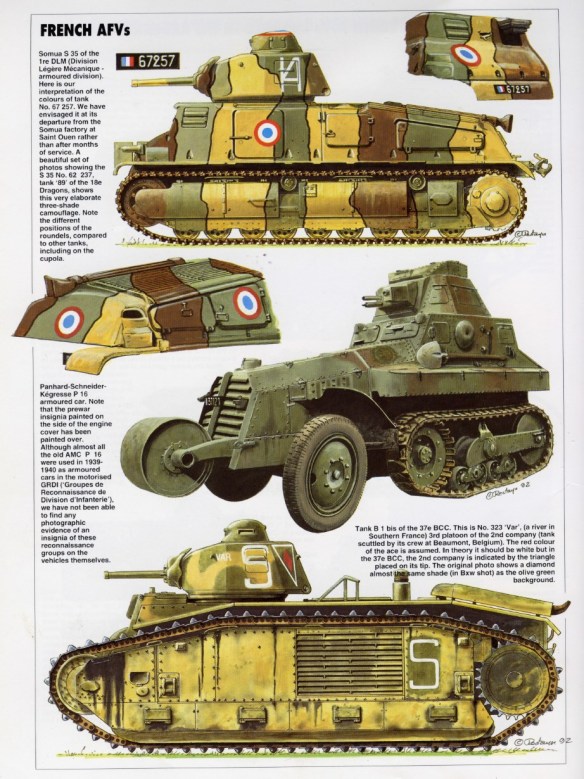In August 1939, during a conference on the use of armored units held by the 511th Tank Regiment at Verdun, French and German doctrines were compared. The Germans, it was said, preferred mass engagement on a broad front. It was predicted they would use large tank formations on favorable terrain and try to take the enemy by surprise to prevent the enemy from concentrating mobile AT defenses at the point of attack. Their independent armored divisions-assembled in an armored corps and supported by the infantry and the artillery-would be able to penetrate the front and exploit it to the limit.
The French, on the other hand, preferred using armored units within and subordinated to infantry formations. The role of these units was to break the front, exploiting it to a limited degree, and allow other types of units to complete the breakthrough. The officer who organized the conference attributed the differences between the German and French doctrines on tank usage to the nature of the fortifications facing them. The Maginot Line, which had little depth, and the Siegfried Line (West Wall), which he speculated was up to thirty kilometers deep, required different approaches. After the conference, the French doctrine underwent slight adjustments. Thus, the DCR, intended for attacking well-organized positions and exploitation of breakthroughs, would lead counterattacks. The assault against a strong enemy position would devolve on a combined force dominated by the infantry. The DCR would be pitched into the battle at a critical moment to penetrate the front. Hot on its heels, the Hotchkiss tanks and the mechanized infantry would pounce on the enemy, reducing the enemy’s positions.
In February, despite the freezing weather, the first two DCRs began training and maneuvers. These divisions relied on a radio company for communications, but their tanks still lacked radios, and their tank crews had to rely on hand signals. The crucial radio units had already been designed, but few had been installed in the tanks by the spring of 1940. This infuriated Colonel de Gaulle, who exclaimed “Without radios were are f***ed!” (Ferrard, France 1940, pp. 110-113).
Sumner Waite’s Account of Tank Maneuvers
During the end of the first week of February 1940, a week after the formation of the 1st Armored Groupement, Lieutenant Colonel (LTC) Sumner Waite, American military attaché in France, was invited to visit the two new DCRs as they began their training at the Suppes maneuver area. He found the area still had German trenches and bunkers from the last war. The colonel in charge of the aviation section informed Waite that two dive-bomber squadrons would be added to the unit. 6 When Waite reached the 37th Tank Battalion of the 1st DCR, the icy conditions were not very conducive to training, but morale was high, and the troops were enthusiastic. The tanks, which were scattered around, had to be started four times every twenty-four hours to protect them from freezing. This weather was ideal neither for training nor for a German offensive. The troops, billeted in farmhouses and barns and trying desperately to keep warm, were looking for small stoves. Despite this, morale was high when General Bruneau, commander of the 1st DCR arrived.
The two new divisions were given two months to complete their training. The bad weather in February seriously hampered training. Sumner Waite, an infantryman, was allowed to take over the controls of a Char B. Later, he wrote that he “was amazed, from a driving standpoint, at the facility with which it was possible to increase speed and change direction” and noted that the tank steered “as easily as an automobile.”
Although many of the personnel in these divisions consisted of reservists, they gave “the impression that they had been soldiering for years,” noted Waite. The “keenness and enthusiasm of reserve officers as well as regulars throughout for their tanks, guns or what-not, and the pride of the men in their respective organizations make an excellent foundation upon which to build divisional esprit de corps,” he reported. These men, he added, were “ready to meet the best the enemy has.” This was a far cry from the sorry troops General Montgomery claimed to have encountered.
At the time of Waite’s report, about 100 Char B tanks were used in training or held in reserve. Another 189 were assigned to units or reserve in accordance with the French policy of keeping 50% of their heavy tanks in reserve. Trucks from a transport company from the GHQ Reserve transported the tanks. The men of this transport company were nicknamed “bandits” by the officers in the armored units because they were undisciplined and sloppy.
Since the French had supposedly lost only one Renault tank in combat during the Phony War, the officers were satisfied that the armor of their tanks could withstand most AT weapons. Their greatest concern was the AT mine. Waite, impressed by what he saw during his visit, was convinced that the French DCR had greater striking power than the German armored units did. He was not aware that the Germans had reduced the tank strength of their panzer divisions to double the number of divisions, and that their supporting services were much more effective (Attaché Report 25,501-W, March 1940, “Organization of Divisions”).

